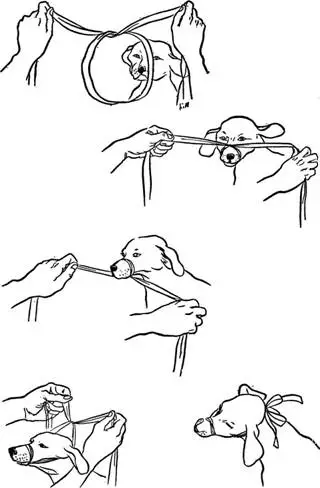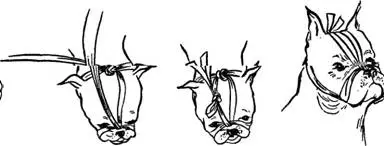Dogs that are injured or are otherwise in pain are often difficult to handle. Even the most gentle and affectionate animals will occasionally attempt to bite or claw under these circumstances. Thus some knowledge of restraint is necessary for the owner to protect himself while making an effort to assist an ailing animal.
One of the simplest and best known methods of restraint is for one person to grasp the nape of the dog’s neck firmly, while another ministers to the animal’s needs. Another method is to approach the animal from behind and hold both hands flat on either side of the neck, close to the ears and the angle of the jaws, with the thumbs joining on top of the neck. If one person holds the animal firmly in this manner, while another does what has to be done, this procedure will be effective in most cases. The animal must be held firmly while being treated, regardless of how much it squirms, because to relax the grip may be dangerous to both persons doing the treating.
Another method that is useful when the owner has no assistance is to hook the leash on the animal’s collar and then to tie the animal very close to a firm object. Since the animal cannot effectively move its head when it is so restrained, treatment can be applied to other parts of the body with a minimum of danger to the owner.
One of the most effective restraint measures is the application of a bandage muzzle.

- Make a loop with a piece of bandage about two or three feet long.
- Apply this loop to the animal’s mouth and tighten the knot on the bridge of the animal’s nose, about an inch and a half or two inches away from the end of the nose.
- Then turn the two free ends of the bandage underneath the animal’s mouth and make another knot there.
- Loop the bandage around the back of the animal’s ears onto the neck and make a bow knot there. The animal can then be held in any convenient manner, and treated wherever necessary, without the danger of the operator being bitten.
- When the treatment is over, the bow knot on the back of the neck is released and the bandage is pulled off the mouth.
There are obvious variations of this procedure. But its purpose and basic technique are quite clear.
A modification of the bandage muzzle that is especially adapted to short-nosed dogs follows the same technique up to the point where the bandage is tightened at the top of the neck. At this point, instead of making a bow knot directly, as for a long-nosed dog, pass one of the free ends of the bandage forward between the eyes and loop it underneath the muzzle on the bridge of the nose. Then bring it back between the eyes onto the top of the neck and make a bow knot there as with the muzzle for the ordinary long-nosed dog.

The advantage of this type of muzzle is that it does not exert too much pressure on the bridges of short-nosed dogs, and they can thus wear it more comfortably. Also it will not have a tendency to slip and cannot be too easily torn off the face during the course of the treatment.
These methods of restraint will serve most of the owner’s needs. In instances where the owner simply cannot approach the animal, it is safest to call upon professional assistance so that special measures can be applied that are adaptable to the individual circumstances.